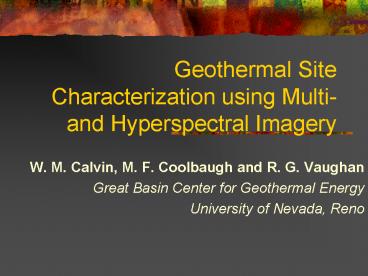Geothermal Site Characterization using Multi and Hyperspectral Imagery
1 / 21
Title: Geothermal Site Characterization using Multi and Hyperspectral Imagery
1
Geothermal Site Characterization using Multi- and
Hyperspectral Imagery
- W. M. Calvin, M. F. Coolbaugh and R. G. Vaughan
- Great Basin Center for Geothermal Energy
- University of Nevada, Reno
2
Overview
- Why Remote Sensing?
- Motivation/Objectives
- Wavelength ranges and their applications
(VNIR/SWIR/TIR) - Spectral Resolution (5 bands vs 225)
- Spatial Resolution (2m vs 90m)
- Field Sites and Studies
- Available Data Sets
- Steamboat Springs Mineral Mapping
- Steamboat Springs Thermal anomalies
- Brady Hot Springs Thermal anomalies,
- groundwater anomalies, playa evaporites
- Future Directions
3
Why Remote Sensing?
- Regional Coverage
- Information content beyond simple aerial
photography - Established exploration tool mining/petroleum
industries, site assessment in environmental
studies - Significant recent advances in sensor resolution
and sensitivity - Map minerals, vegetation, surface temperature
MODIS Image acquired Feb. 2002
4
Motivation
- A wide range of properties could be related to
the surface expression of geothermal sources. - We wish to systematically explore the correlation
between various remotely derived properties and
known sources to assess their utility in
discovering unknown geothermal regions. - Use both multi-spectral and hyperspectral data at
different wavelengths and resolutions to
determine the most effective data sets for site
exploration and characterization.
5
Geothermal Indicators?
- Vegetation
- Stress Faults
- Lack surface heat flow
- / alteration
- Kills CO2 outgassing
- Mineral/Rocks
- Sinter
- Alteration Zones
- Evaporites
- Thermal Signatures
Brady Hot Springs, photo by Mark Coolbaugh
6
Spectral Ranges
- VNIR (0.4 to 1.1 mm)
- Vegetation
- Fe-oxides
- Sulfides/Oxides
- SWIR (1.0 to 2.5 mm)
- Alteration
- clays, chlorites, sulfates, carbonates, borates
- TIR (7 to 15 mm)
- Silicates quartz, feldspars
- Temperature
Steamboat Springs Main Terrace, photo by Greg
Vaughan
7
Resolution
- Spectral Resolution
- Data Volume
- Multi-band data historically had better spatial
resolution but limited mapping of high fidelity
spectral properties - Modern hyperspectral sensors typically achieve 2m
spatial resolution with several hundred channels
- Spatial Resolution
- Swath vs ground pixel
- Large image width typically means poorer ground
resolution. - Higher spatial resolution usually limits width of
scene. - Signal-to-noise in modern instruments is
significantly improved.
8
Data Sets Used
HyperSpectral (aircraft)
Multi-Band
AVIRIS (224) SpecTIR (225) HyMap (128)
ASTER (spaceborne) 9 channels MASTER(airborne)
25 channels
VNIR/SWIR
TIMS (6) ASTER (5) MASTER (10)
TIR
SEBASS (128)
9
Field Sites and Studies
- Steamboat Springs
- Mineral Mapping with SEBASS
- Comparison of SEBASS/MASTER
- Thermal Anomalies with TIMS
- Brady Hot Springs
- Thermal Anomalies with ASTER
- Regional Alteration patterns ASTER/SpecTIR
- Dixie Valley (future)
- Vegetation and mineral mapping with HyMAP
10
Steamboat Mineral Mapping
Steamboat Terrace from Geiger Grade, photo by
Greg Vaughan
11
Flight Locations
SEBASS
MASTER
12
SEBASS Classification
photo by Greg Vaughan
13
SEBASS/MASTER
14
Steamboat Thermal Anomalies
- Use TIMS day/night
- Developed slope correction for solar incidence
- Use albedo correction
- Empirical approach to thermal inertia
- Hot spots well correlated with known vents
15
Heat Flux Anomalies 3 band image
topography TIMS night band 5 TIMS day band
5 NO adjustments for slope aspect
albedo sinter thermal inertia red-orange
thermal yellow thermal /-
background green-blue
background circle fumaroles 1 km
N
16
Heat Flux Anomalies Average Day Night TIMS
band 5 radiance with subtraction for slope aspect
albedo With Topo Shading Anomaly
Strength red strong yellow-green
moderate blue weak 1
km
N
17
Brady Thermal Anomalies
- Based on methods successful at Steamboat.
- Use ASTER - concurrent vnir/tir data should
improve albedo correction - Field validation of reflectance and temperature
at time of flight. Diurnal solar input. - Field measurements of inertia to constrain
endmembers. - UNR Class project Taranik/Coolbaugh
- Assess utility of ASTER to find unknown sources.
18
Brady
Desert Peak
Fernley
Soda Lake
19
TIR anomaly gt 2 kilometers long Bradys hot
springs
Andesite flows
thermal anomalies
Upsal Hogback
Brady Hot Springs, photo by Mark Coolbaugh
20
Future Directions
- Completion of Brady Thermal Project
- Addition of VNIR/SWIR Hyperspectral
- Regional Alteration patterns at Brady with
ASTER/SpecTIR - Synthesis of VNIR/SWIR TIR at Steamboat
- GIS synthesis of mineral thermal maps with
known sources at Steamboat. Unique identifiers of
resource potential? - Dixie Valley (with Pickles-LLNL Nash-EGI)
- Vegetation and mineral mapping with HyMAP
21
Acknowledgements
- Supported By
- Arthur Brant Lab for Exploration Geophysics
Endowment - NASA Graduate Student Research Fellowship with
JPL (Greg Vaughan) - NASA Space Grant (Mark Coolbaugh)
- U.S. Department of Energy under instrument number
DE-FG07-02ID14311.































